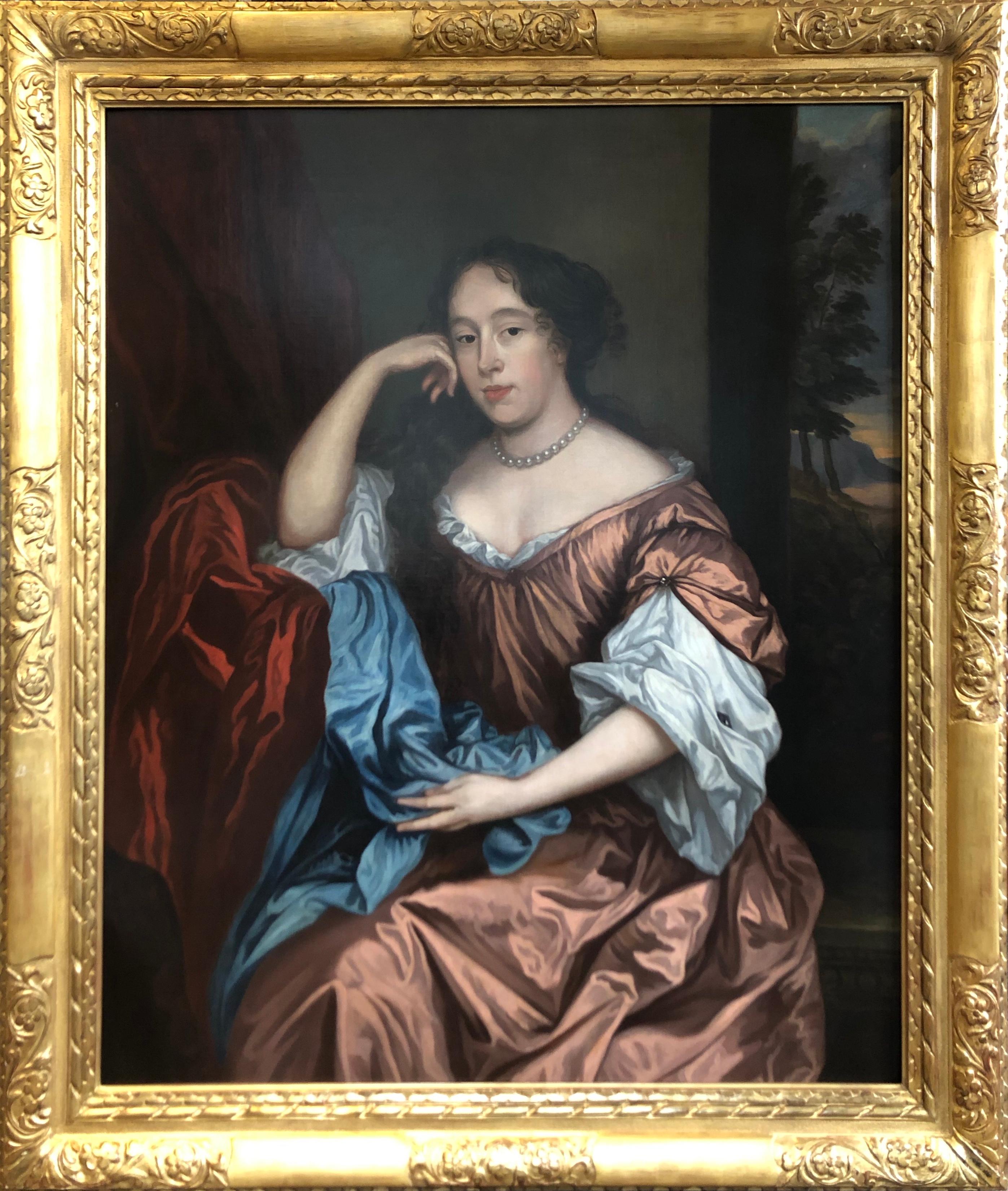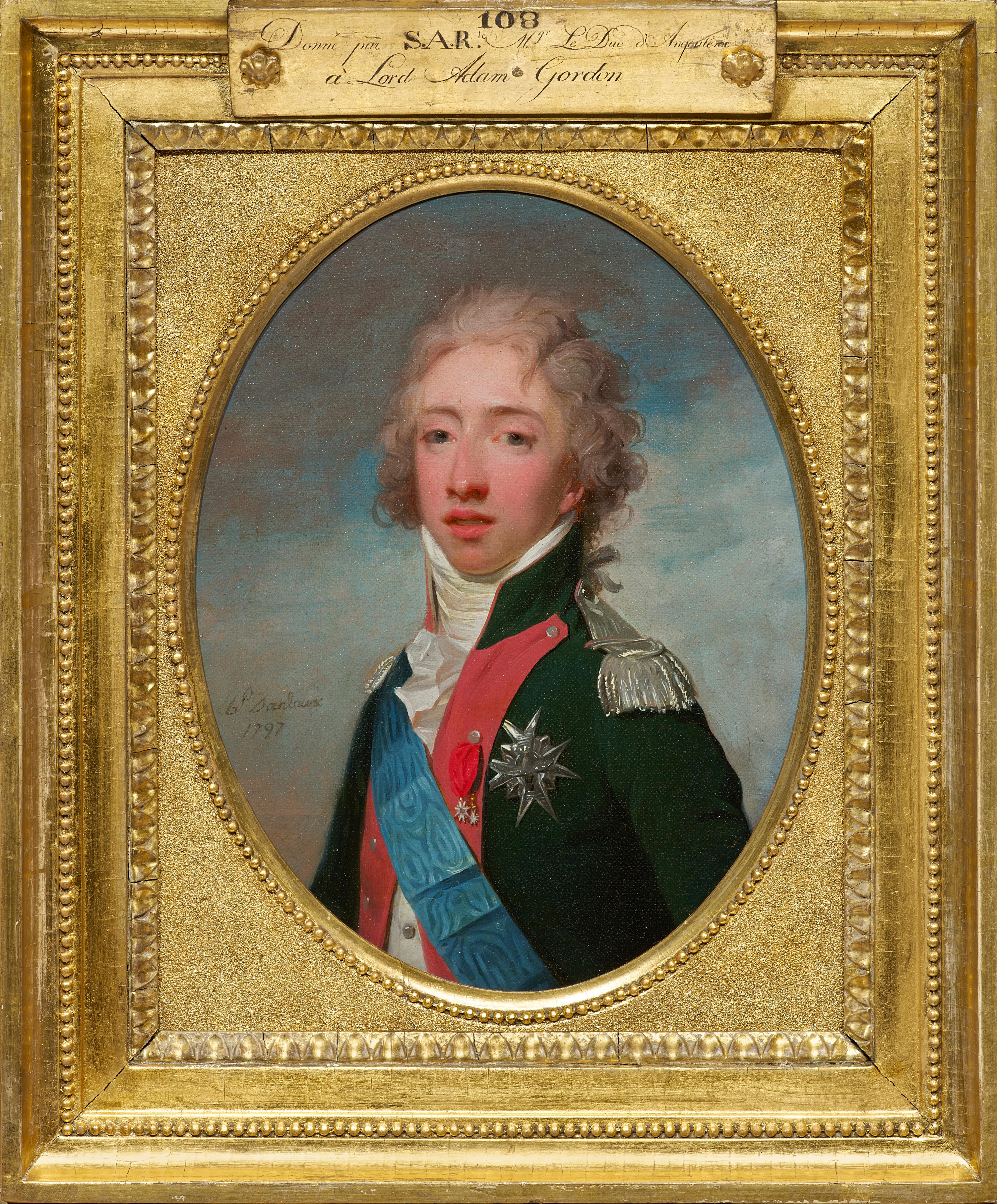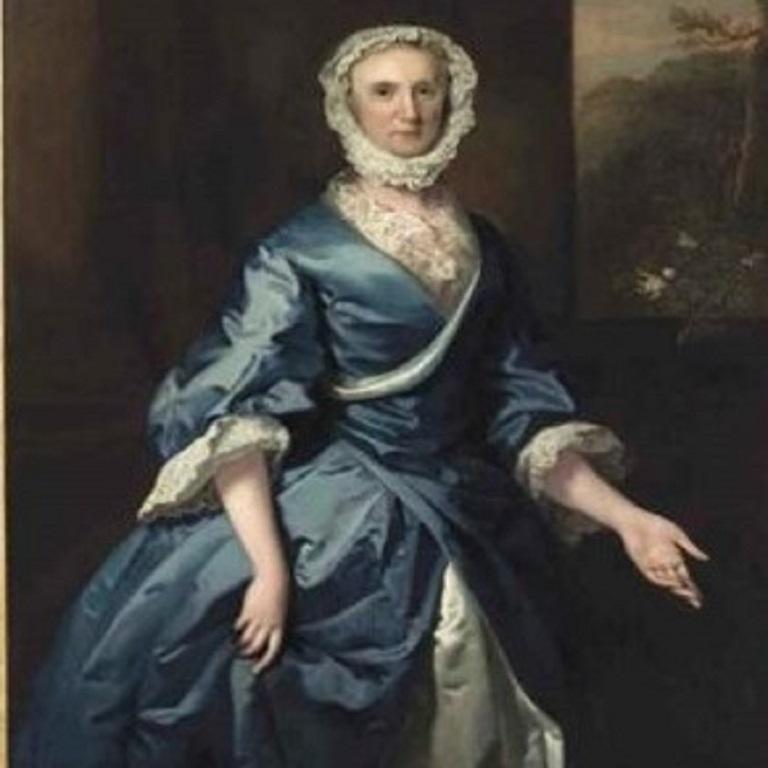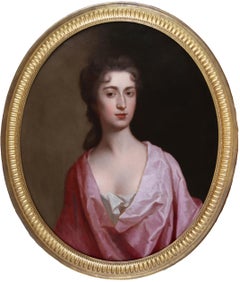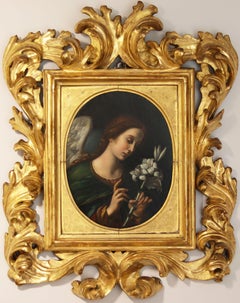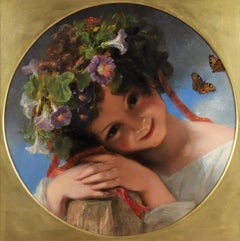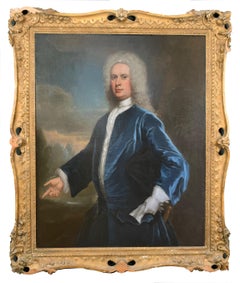
Portrait of William Shakespeare
View Similar Items
Want more images or videos?
Request additional images or videos from the seller
1 of 7
UnknownPortrait of William Shakespearecirca 1730
circa 1730
About the Item
- Creation Year:circa 1730
- Dimensions:Height: 28 in (71.12 cm)Width: 24 in (60.96 cm)
- Medium:
- Movement & Style:
- Period:
- Condition:
- Gallery Location:West Sussex, GB
- Reference Number:1stDibs: LU152527790072
About the Seller
5.0
Vetted Seller
These experienced sellers undergo a comprehensive evaluation by our team of in-house experts.
Established in 2002
1stDibs seller since 2021
37 sales on 1stDibs
Typical response time: A week
More From This SellerView All
- Portraits of Francis Wood, and John Wood of Hollin Hall, Yorkshire (Pair))Located in West Sussex, GBA Superb pair of oval portraits with full provenance. Portrait of John Wood Esq of Hollin Hall, Yorkshire; Portrait of Francis Wood. Circa 1710. Oils on canvas:29 x 24 in. Frame: 37...Category
Early 18th Century Old Masters Portrait Paintings
MaterialsOil
$22,247Free Shipping - The Angel GabrielLocated in West Sussex, GBAfter Carlo Dolci "The Angel Gabriel" Oil on Canvas: Painted oval form :13 x 11 in. Frame: 29 x 23 in. Fine carved giltwood Florentine frame. Late 18t...Category
17th Century Baroque Portrait Paintings
MaterialsOil
- Portrait of an Enchanting Young Girl Wearing a Garland of Morning Glory FlowersBy James HollandLocated in West Sussex, GBAttributed to James Holland (1799 -1870) and William Henry Hunt (1790-1864) A Portrait of a Young Girl Wearing a Garland of Morning Glory Flowers Oil on canvas: 17 ½ x 18 in. Frame: 23 ½ x 24 in. Circa 1820 An enchanting head and shoulders portrait of a young girl wearing a white shift...Category
Early 19th Century Pre-Raphaelite Portrait Paintings
MaterialsOil
- A Pair of 18th century Venetian Canal Scenes in the Style of Francesco GuardiLocated in West Sussex, GBStyle of Francesco Guardi (1712-1793) Venetian Canal Scenes, a pair -San Giorgio Maggiore from the Bacino di San Marco -Santa Maria della Salute from the Grand Canal Oils on canvas: 13 X 18 ¼ in. Frame: 18 ½ x 23 ½ in. Late 18th / early 19th century. Francesco Guardi was an Italian painter of veduta, nobleman, and a member of the Venetian School. He was born in Venice in 1712, the son of a minor painter, Domenico Guardi, and went on to become, after Canaletto, the main painter of views of Venice in the mid-18th century. His early figurative paintings were carried out in association with his brother, Gian Antonio, but in about 1760 Guardi turned to view painting, recording both the architecture of the city and the celebrations of its inhabitants in interior and exterior scenes. These works brought him great success. The earliest of these show the influence of Canaletto, but he gradually adopted a looser style characterized by spirited brush-strokes and freely imagined architecture. Gallery notes: This fabulous pair of Venetian scenes are a work by a highly talented but unknown artist painting...Category
Late 18th Century Old Masters Landscape Paintings
MaterialsOil
- Road to Biot, Provence, FranceBy Emily Beatrice BlandLocated in West Sussex, GBEmily Beatrice Bland (1864-1951) British Road to Biot, Provence Oil on board. 8 x 10 in. Frame.12 x 14 in. Signed and titled on label on reverse...Category
Early 20th Century Impressionist Landscape Paintings
MaterialsOil
- Winter in Sussex `78Located in West Sussex, GBVernon Southward (1911-81) British Winter in Sussex `78 Exhibited: Paris Salon1980. No.2959, illustrated. Oil on Canvas: 16 x 20 in. frame. 23 x 27. Signed& dated ’78. Original Ga...Category
20th Century Impressionist Landscape Paintings
MaterialsOil
You May Also Like
- Portrait of a Lady, After Sir Peter Lely (1610-1680) Oil PaintingBy After Sir Peter LelyLocated in Uppingham, GBOil Painting After Sir Peter Lely (1610-1680) Portrait of a Lady Housed in a Lely gold Leaf Frame. Peter Lely: In 1647 he became a member of the Pain...Category
17th Century Old Masters Portrait Paintings
MaterialsOil
- Oil Painting Portrait, attributed to John Vanderbank (1694-1739)By John VanderbankLocated in Uppingham, GBOil Painting Portrait of John Campbell, 4th Duke of Argyll,, att to John Vanderbank (1694-1739) Housed in a swept frame which has been restored after photo. Canvas Size 50" x 40", Fr...Category
1690s Old Masters Portrait Paintings
MaterialsCanvas, Oil
- 19th century portrait painted in St Petersburg in 1819Located in London, GBSigned, inscribed and dated, lower right: 'Geo Dawe RA St Petersburgh 1819', also signed with initials, lower centre: 'G D RA'; and signed and inscribed verso: 'Geo Dawe RA Pinxit 1819 St Petersburgh'; Also inscribed on the stretcher by Cornelius Varley with varnishing instructions. Collections: Private collection, UK, 2010 Literature: Galina Andreeva Geniuses of War, Weal and Beauty: George Dawe...Category
19th Century Old Masters Portrait Paintings
MaterialsCanvas, Oil
- Portrait of Jean-Baptiste Greuze, painted on linen by his daughter Anna GreuzeLocated in PARIS, FRThis replica of the last self-portrait of Jean-Baptiste Greuze painted in 1804, executed by his daughter Anna at her father's side and recently rediscovered, provides us with a poignant image of the great artist, represented with panache despite the disillusions of life. 1. Jean-Baptiste Greuze Jean-Baptiste Greuze was the sixth child of a roofer from Tournus and retained a certain rusticity in his behaviour from his provincial childhood, beyond his taste for describing picturesque scenes of the countryside. He initially started training with a little-known painter from Lyon, Charles Grandon, before his genius was recognised in Paris where he became a full-time student of the Académie (of Painting) in 1755. He exhibited his work for the first time at the Salon during the summer of 1755, before leaving on a trip to Italy in the company of Louis Gougenot, abbot of Chezal-Benoît. Upon his return to Paris, Greuze became a prolific painter, participating widely in the Salons held between 1759 and 1765, to which he sent no less than 63 paintings: numerous genre scenes (The Marriage Contract, The Beloved Mother), but also portraits of his family circle, of courtiers and art lovers, or of his colleagues. The Academy closed the doors of the Salons to him in 1767 for not having produced his reception piece within six months of his reception, as was the tradition. He worked actively on this painting (Emperor Severus rebukes Caracalla, his son, for trying to assassinate him ) until the summer of 1769, tackling historical and mythological subjects for the first time. Once this was completed, he was then fully admitted to the Academy, but as a genre painter, and not as an historical painter, which had been one of the greatest humiliations of his life. Greuze then refused any participation in events organised by the Academy or its successor, the Academy of Fine Arts until 1800. Abandoning history painting, he gave a new twist to genre scenes, bringing them closer to history painting, as in this pair of canvases which constitutes some of his masterpieces: The Paternal Curse: The Ungrateful Son and The Paternal Curse: The Punished Son . Married in 1759 to Anne-Gabrielle Babuti, the daughter of a Parisian bookseller, his marriage was unhappy and his wife probably frequently unfaithful. The institution of divorce enabled him to record their separation in 1793, keeping his two daughters Anna-Geneviève, born in April 1762, and Louise-Gabrielle, born in May 1764, with him. Little is known about his daughter Anna except that she was herself a painter and lived with her father until his death. It is likely that most of the paintings she produced up to that date were attributed to her father, whose technique she shared to a great extent, making it extremely difficult to establish an autonomous corpus of her paintings. Greuze died in his studio at the Louvre on March 21st 1805. The attention paid to the expressivity of his characters and the emotional charge they convey enabled Jean-Baptiste Greuze to enjoy immense popularity with the eighteenth-century public, and they still constitute Greuze's true modernity. As the artist said, "I dipped my brush in my heart". Greuze was also an exceptional draughtsman and a portraitist of immense talent and exceptional longevity who painted both the Dauphin (the son of Louis XV and father to Louis XVI) and the young Napoleon Bonaparte. 2. Greuze's self-portraits Greuze was very much influenced by Dutch paintings during all his life. While the source of his inspiration for genre scenes can be found in Gerard Dou...Category
Early 1800s Old Masters Portrait Paintings
MaterialsLinen, Oil
- Portrait of Monsieur Aubert, a ceremonial portrait by Nicolas de LargillièreBy Nicolas de LargillièreLocated in PARIS, FRProvenance : Arnold S. Kirkeby (1901-1962) Donated by Arnold S. Kirkeby to the Los Angeles County Museum of Art in 1955, where it remained until its sale at Sotheby's, New York on Ja...Category
1720s Old Masters Portrait Paintings
MaterialsOil
- Two royal portraits (the Duc d'Angoulême and the Duc de Berry) by H.P. DanlouxLocated in PARIS, FRThese two royal portraits are a major historical testimony to the stay of the Comte d'Artois (the future Charles X) and his family in Edinburgh in 1796-1797. Given by the sitters to Lord Adam Gordon, the Governor of Edinburgh, and kept by family descent to this day, these two portraits provide us with a vivid and spontaneous image of the Duc d’Angoulême and his brother the Duc de Berry. Danloux, who had emigrated to London a few years before, demonstrate his full assimilation of the art of British portrait painters in the brilliant execution of these portraits. 1. Henri-Pierre Danloux, a portraitist in the revolutionary turmoil Born in Paris in 1753, Henri-Pierre Danloux was first a pupil of the painter Nicolas-Bernard Lépicié (1735 - 1784) and then, in 1773, of Joseph-Marie Vien (1716 - 1809), whom he followed to Rome when, at the end of 1775, Vien became Director of the Académie de France. In Rome he became friends with the painter Jacques-Louis David (1748 - 1825). Returning to France around 1782, he settled in Lyon for a few years before returning to Paris in 1785. One of his first portraits was commissioned by the Baroness d'Etigny, the widow of the former Intendant of the Provinces of Gascony, Bearn and Navarre Antoine Mégret d'Etigny (1719 – 1767). He then became close to his two sons, Mégret de Sérilly and Mégret d'Etigny, who in turn became his patrons. In 1787, this close relationship with the d'Etigny family was further strengthened by his marriage to Antoinette de Saint-Redan, a relative of Madame d'Etigny. After his marriage, he left for Rome and did not return to France until 1789. It was during the winter of 1790-1791 that he painted one of his masterpieces, the portrait of Baron de Besenval. Set in a twilight atmosphere, this portrait of an aristocrat who knows that his death is imminent symbolizes the disappearance of an erudite and refined society which would be swept away by the French Revolution. The Jacobin excesses led Danloux to emigrate to England in 1792; many members of his family-in-law who remained in France were guillotined on 10 May 1794. Danloux enjoyed great success as a portrait painter in England before returning to France in 1801. During his stay in England, Danloux was deeply under the influence of English portraitists: his colors became warmer (as shown by the portrait of the Duc d'Angoulême that we are presenting), and his execution broader. 2. Description of the two portraits and biographical details of the sitters The Duc d'Angoulême (1775-1844) was the eldest son of the Comte d'Artois, the younger brother of King Louis XVI (the future King Charles X), and his wife Marie-Thérèse of Savoie. He is shown here, in the freshness of his youth, wearing the uniform of colonel-general of the "Angoulême-Dragons" regiment. He is wearing the blue cordon of the Order of the Holy Spirit, which was awarded to him in 1787, and two decorations: the Cross of Saint-Louis and the Maltese Cross, as he was also Grand Prior of the Order of Malta. Born on 16 August 1775 in Versailles, Louis-Antoine d'Artois followed his parents into emigration on 16 July 1789. In 1792, he joined the émigrés’ army led by the Prince de Condé. After his stay in Edinburgh (which will be further discussed), he went to the court of the future King Louis XVIII, who was in exile at the time, and in 1799 married his first cousin Marie-Thérèse Charlotte of France, the daughter of Louis XVI and the sole survivor of the royal family. The couple had no descendants. He became Dauphin of France in 1824, upon the accession to the throne of his father but played only a minor political role, preferring his military position as Grand Admiral. Enlisted in Spain on the side of Ferdinand VII, he returned home crowned with glory after his victory at Trocadero in 1823. He reigned for a very short time at the abdication of Charles X in 1830, before relinquishing his rights in favor of his nephew Henri d'Artois, the Duc de Bordeaux. He then followed his father into exile and died on 3 June 1844 in Gorizia (now in Italy). His younger brother, the Duc de Berry, is shown in the uniform of the noble cavalry of the émigrés’ Army. He is wearing the blue cordon of the Order of the Holy Spirit, awarded to him in May 1789, and the Cross of Saint-Louis (partly hidden by his blue cordon). Born on 24 January 1778 in Versailles, Charles-Ferdinand d'Artois also followed his parents into emigration and joined the émigrés’ army in 1792. After his stay in Edinburgh, he remained in Great Britain, where he had an affair with Amy Brown...Category
1790s Old Masters Portrait Paintings
MaterialsCanvas, Oil, Wood Panel
Recently Viewed
View AllMore Ways To Browse
Young Edwardian
Margaret Thomas
Diamond Dealers Los Angeles
18th Century Scottish Painting
Los Angeles Travel Poster
Travel Poster Los Angeles
Oil Portrait 1700
Mosaic Wall Art Portraits
Lady Jane
Portrait Lady In Green
Prince Henry
Jon Wood
British Military Portrait
Yves Klein Blue Venus
Gold Ring Painted Portrait
King Edward I
Girl Portrait Painting 1960s
Oil Portrait Napoleon
